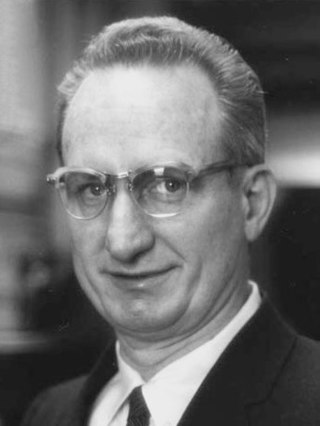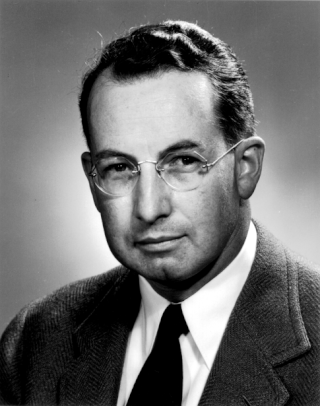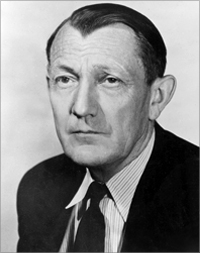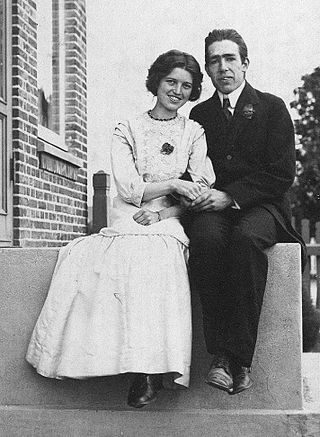Related Research Articles

Aage Niels Bohr was a Danish nuclear physicist who shared the Nobel Prize in Physics in 1975 with Ben Roy Mottelson and James Rainwater "for the discovery of the connection between collective motion and particle motion in atomic nuclei and the development of the theory of the structure of the atomic nucleus based on this connection". Starting from Rainwater's concept of an irregular-shaped liquid drop model of the nucleus, Bohr and Mottelson developed a detailed theory that was in close agreement with experiments.

Niels Henrik David Bohr was a Danish physicist who made foundational contributions to understanding atomic structure and quantum theory, for which he received the Nobel Prize in Physics in 1922. Bohr was also a philosopher and a promoter of scientific research.

The Niels Bohr Institute is a research institute of the University of Copenhagen. The research of the institute spans astronomy, geophysics, nanotechnology, particle physics, quantum mechanics and biophysics.

Abraham Pais was a Dutch-American physicist and science historian. Pais earned his Ph.D. from University of Utrecht just prior to a Nazi ban on Jewish participation in Dutch universities during World War II. When the Nazis began the forced relocation of Dutch Jews, he went into hiding, but was later arrested and saved only by the end of the war. He then served as an assistant to Niels Bohr in Denmark and was later a colleague of Albert Einstein at the Institute for Advanced Study in Princeton, New Jersey. Pais wrote books documenting the lives of these two great physicists and the contributions they and others made to modern physics. He was a physics professor at Rockefeller University until his retirement.

Ben Roy Mottelson was an American-Danish nuclear physicist. He won the 1975 Nobel Prize in Physics for his work on the non-spherical geometry of atomic nuclei.

Leo James Rainwater was an American physicist who shared the Nobel Prize in Physics in 1975 for his part in determining the asymmetrical shapes of certain atomic nuclei.
Gaja Alaga was a Croatian theoretical physicist who specialised in nuclear physics.

William Alfred Fowler (9 August 1911 – 14 March 1995) was an American nuclear physicist, later astrophysicist, who, with Subrahmanyan Chandrasekhar, won the 1983 Nobel Prize in Physics. He is known for his theoretical and experimental research into nuclear reactions within stars and the energy elements produced in the process and was one of the authors of the influential B2FH paper.

Robert Fox Bacher was an American nuclear physicist and one of the leaders of the Manhattan Project. Born in Loudonville, Ohio, Bacher obtained his undergraduate degree and doctorate from the University of Michigan, writing his 1930 doctoral thesis under the supervision of Samuel Goudsmit on the Zeeman effect of the hyperfine structure of atomic levels. After graduate work at the California Institute of Technology (Caltech) and the Massachusetts Institute of Technology (MIT), he accepted a job at Columbia University. In 1935 he accepted an offer from Hans Bethe to work with him at Cornell University in Ithaca, New York. It was there that Bacher collaborated with Bethe on his book Nuclear Physics. A: Stationary States of Nuclei (1936), the first of three books that would become known as the "Bethe Bible".

Charles Christian Lauritsen was a Danish/American physicist.

Edoardo Amaldi was an Italian physicist. He coined the term "neutrino" in conversations with Enrico Fermi distinguishing it from the heavier "neutron". He has been described as "one of the leading nuclear physicists of the twentieth century." He was involved in the anti-nuclear peace movement.

Herbert Lawrence Anderson was an American nuclear physicist who was Professor of Physics at the University of Chicago.
Horace Richard Crane was an American physicist, the inventor of the Race Track Synchrotron, a recipient of President Ronald Reagan's National Medal of Science "for the first measurement of the magnetic moment and spin of free electrons and positrons". He was also noted for proving the existence of neutrinos. The National Academy of Sciences called Crane "an extraordinary physicist". The University of Michigan called him "one of the most distinguished experimental physicists of the 20th century". Crane was a chairman of the department of physics and a professor of physics at the University of Michigan, a member of the National Academy of Sciences.
The Bohr family is a Danish family of scientists, scholars and amateur sportsmen.

John M. "Jack" Carpenter was an American nuclear engineer known as the originator of the technique for utilizing accelerator-induced intense pulses of neutrons for research and developing the first spallation slow neutron source based on a proton synchrotron, the Intense Pulsed Neutron Source (IPNS). He died on 10 March 2020.
Sven Gösta Nilsson was a Swedish theoretical physicist at the Lund Institute of Technology.
Władysław J. (Wladek) Świątecki was a Polish theoretical and nuclear physicist. He was one of the first proponents of the island of stability for superheavy elements, showing that it appears in a mass formula influenced by the presence of closed nuclear shells; he is also known for several other contributions in nuclear structure research.

John Simpson is a British nuclear physicist. He is known for his work in gamma-ray spectroscopy and detector design. He was Head of Technology, Division of Technology Department. and was Head of the Nuclear Physics Group at STFC Daresbury Laboratory. He is a visiting professor of physics at the University of Liverpool.
Arthur Kent Kerman was a Canadian-American nuclear physicist, a fellow of the American Physical Society, Fellow of the American Academy of Arts and Sciences, and Fellow of the New York Academy of Sciences. He was a professor emeritus of physics at Massachusetts Institute of Technology’s Center for Theoretical Physics (CTP) and Laboratory for Nuclear Science. He was known for his work on the theory of the structure of nuclei and on the theory of nuclear reactions.

Margrethe Nørlund Bohr was the Danish wife of and collaborator, editor and transcriber for physicist Niels Bohr who received the Nobel Prize. She also influenced her son, Nobel Prize winner Aage Bohr.